Some plants are heavy feeders, relying on the application of fertilizers every year to grow and produce fruit.
Pomegranates, however, are not included in that category.
They’re able to grow in soil that is low in organic material, and can tolerate some salt, sand, and drought-like conditions. They may even produce some fruit in harsh environments.
But did you notice how I said they are able to grow in poor soil, and that they may produce fruit, rather than suggesting that they will thrive? This is an important distinction.
Even though your plant may not die in less than ideal conditions, it’s not likely to be at its most productive best.
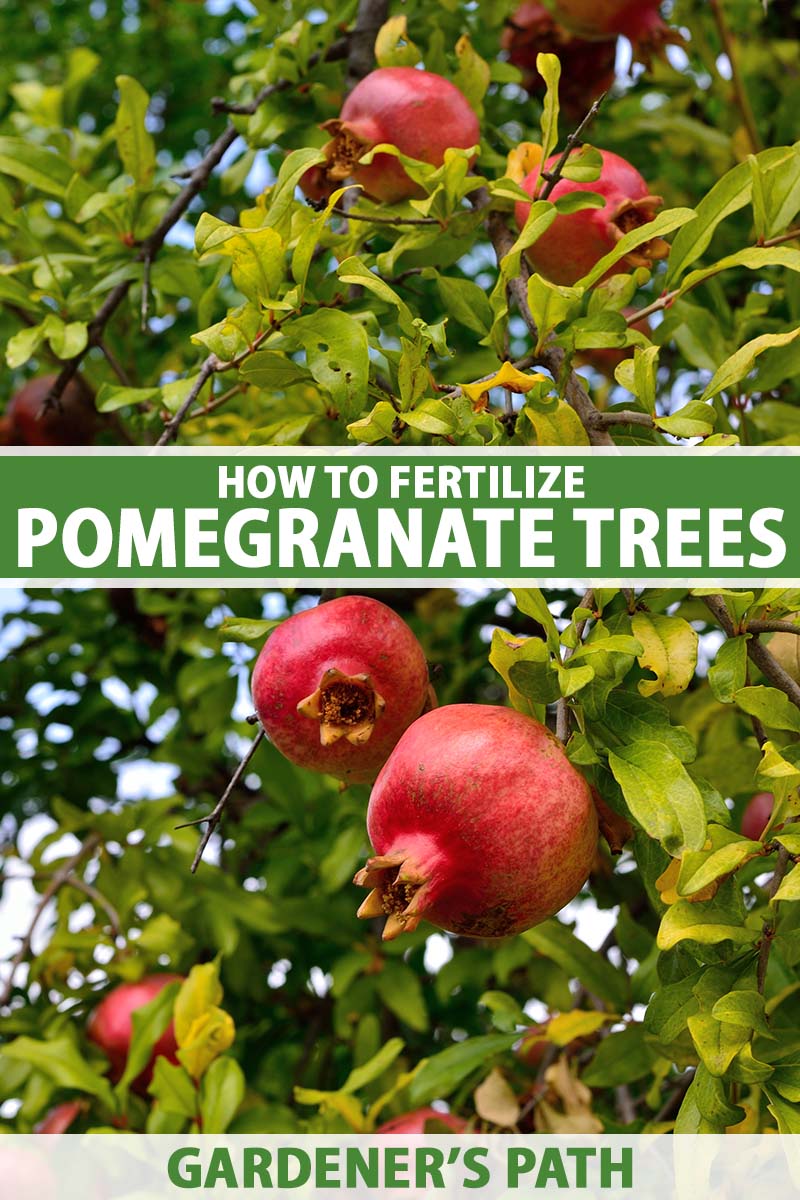
We link to vendors to help you find relevant products. If you buy from one of our links, we may earn a commission.
Pomegranates grown in soil that is lacking may not produce the best quality fruit either. They may be small or bland in flavor, or they may ripen poorly.
It’s better to amend the soil and add fertilizer to meet the needs of your plant, rather than allowing the tree to struggle to survive in unhealthy soil. In this case, however, less is more.
Not sure where to start or how to figure out what your plant needs? Let’s first take a look at the nutritional requirements of Punica granatum before moving on to our recommendations and top tips.
Here’s what’s ahead:
What You’ll Learn
Nutritional Needs
As I mentioned, pomegranates are not finicky plants. Aside from requiring some pruning and watering, they are relatively low maintenance.
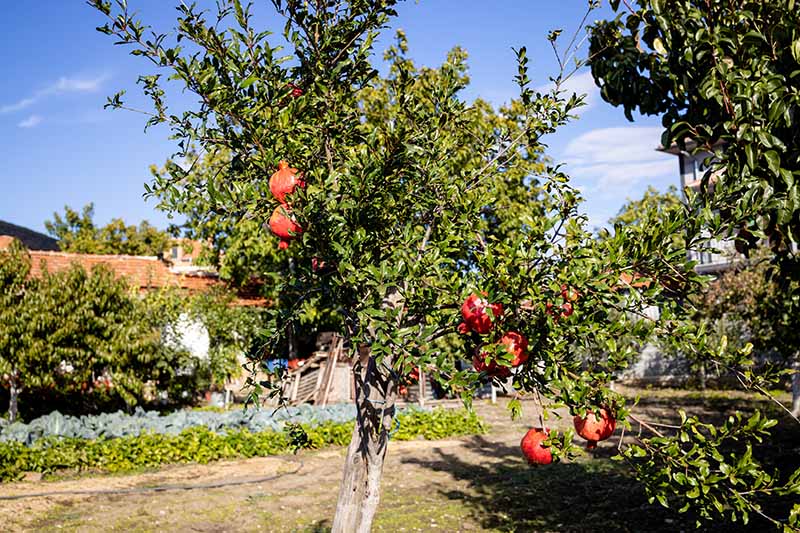
They do, however, have some nutritional requirements that you’ll want to meet to encourage maximum fruit production, and to promote optimal plant health.
In order for these trees or shrubs to produce healthy, well-formed fruits that mature and ripen fully, the soil must have enough potassium available to sustain them, and that can be absorbed readily.
This nutrient is signified by the “K” in the N-P-K macronutrient ratio that you’ll see on fertilizer packaging.
Chlorosis is one sign that fruit is lacking potassium, or in other words, a pale coloration that looks like it’s been bleached, in both the pericarp (on the outside) and the arils (on the inside).
Fruit may also crack prior to maturity if this nutrient is lacking.
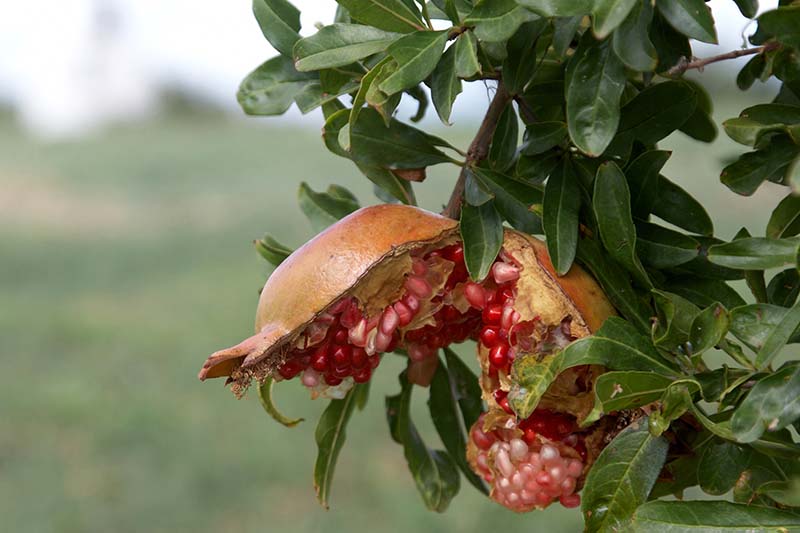
In addition to potassium, nitrogen is very important for maintaining healthy foliage. Nitrogen content is signified by the “N” in the N-P-K ratio on product packaging.
A plant that does not have adequate foliage may allow too much sun to penetrate the canopy, leading to sunscald on the fruit.
Plants that lack sufficient foliage may also have difficulty completing photosynthesis, which can lead to stunting or death.
Signs that nitrogen is deficient include leaf discoloration, such as yellowing, and leaf and bud drop.
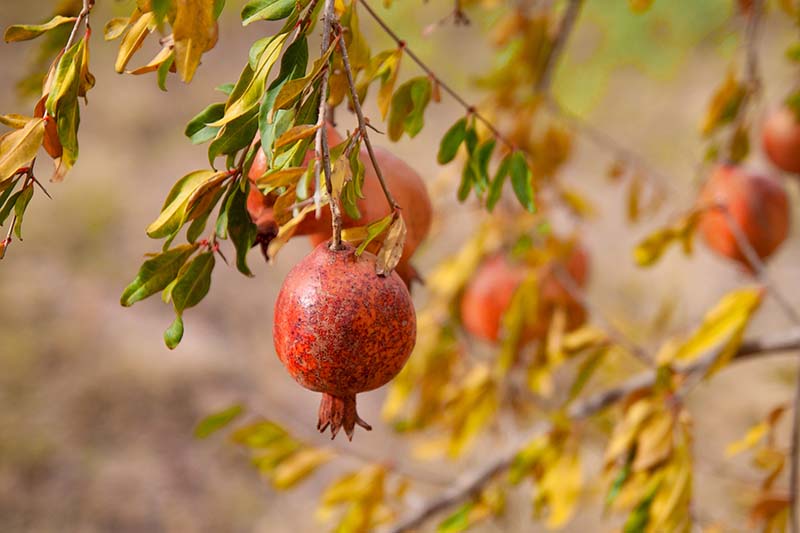
It’s important not to overdo the nitrogen applications, however, as this can lead to a very leafy plant at the expense of fruit production.
Excessive foliage will drain energy from the plant, rather than directing it to reproductive processes. Potassium is very important when trees are budding and setting fruit.
Micronutrients necessary for healthy plant growth include calcium, boron, manganese, magnesium, and zinc. Phosphorus is an important plant macronutrient as well.
Signs that these are lacking may include fruit cracking, leaf yellowing, and the formation of spots on leaves.
When nutrients such as these are deficient, and your plants are under stress, you may also see an increased occurrence of pest infestations and disease.
Another important thing to understand is how nutrients available in the soil affect the pH, and how plant roots are able to absorb what they need from the soil, including water.
For example, soil that is too acidic can lead to serious deficiencies in phosphorus, magnesium, and calcium.
Extremely acidic soil can also cause manganese and aluminum levels to rise, creating a toxic growing environment.
Roots that are exposed to high levels of acidity are essentially poisoned, and completely unable to access nutrients due to the buildup of free metals.
Soil that has pH in the mildly acidic to neutral range of 5.5 to 7.0 is preferred for growing pomegranates.
Anything higher than that in the alkaline range should be addressed by amending the soil to lower the pH. For comprehensive information on addressing soil pH, see our guide to understanding your soil.
There are a few methods of delivering fertilizer available to address these deficiencies.
Types of Fertilizer
There are three main types of commercial fertilizers that you can use to correct nutrient deficiencies in the soil.
Granular Products
The most common type of fruit tree fertilizer is granular.
This type of fertilizer is spread on top of the soil at the base of the plant in a circle around the perimeter that’s as wide as the root system.
The perimeter of the root system is typically aligned with the drip line of the canopy, so spread it to the outer edge.
Granules are generally applied based on the age and size of the tree, according to package directions. We’ll go over this in a bit more detail later in the article, so keep reading!
They are then raked into the soil and watered in well to dissolve after application.
Keep in mind that chemical fertilizers are typically formulated with mineral salts that can build up in the soil over time if excess remains that the plant is not able to use.
Excess salts can also hinder nutrient uptake, making absorption difficult or impossible for the root system.
The best method of reducing the buildup of these salts is to use chemical fertilizers sparingly, and only as needed.
You also want to avoid overwatering to compensate for excessive fertilizer application, though watering well can help to flush out any excess.
Slow-release granular fertilizers provide nutrients that typically last and are distributed gradually for several months, to avoid burning plant roots or dissolving too quickly.

Jobe’s Organic All Purpose Plant Food
An excellent organic option for granular, slow release fertilizer is Jobe’s Organic All Purpose Plant Food, which is a mild 4-4-4 (NPK) formulation available from the Jobe’s Organic store via Amazon.
Liquid Products
Some fertilizers are mixed with water and sprayed on top of the soil. This type sometimes comes in a package of concentrate that can be attached to a hose for easy application.
Other concentrated types may come in a powder form with a scoop included, and you’ll find instructions on the package indicating how many scoops to mix with a certain quantity of water in a sprayer.
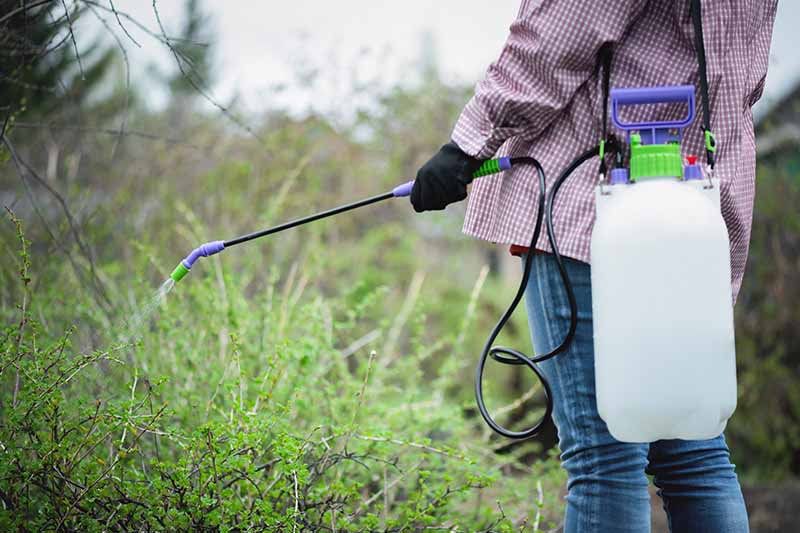
You might also find liquid fertilizers that are pre-diluted and ready to spray without mixing. Generally, any of these liquids can be sprayed on top of the soil to cover the area of the root system.
Other excellent organic sources of nutrients that are gentle and environmentally-friendly include fish and algae emulsion, worm tea made by steeping harvested worm castings in water and watering plants with it, and compost tea which is produced by soaking a cloth “tea bag” full of compost in water and watering plants with the solution.
Foliar Spray
Foliar sprays allow plants to absorb water-soluble nutrients through their foliage, which can be a faster and more reliable method of absorption of certain plant nutrients as opposed to granular or other soil-based applications.
These sprays are often formulated specifically for the treatment of leaf discoloration, and usually contain additional mineral micronutrients such as iron and zinc, which are excellent for pomegranates and citrus fruits.
Foliar sprays are also very useful for adding calcium, which can aid in preventing fruit cracking due to a calcium deficiency.
They are usually pre-diluted and come in a package with instructions explaining the amount to use and frequency of application required, depending on the size and age of the tree.
Compost and worm teas can also be sprayed on the foliage as a helpful organic option.

Purely Organic Products Tomato and Vegetable Food
Pomegranates can benefit from an 8-8-8 (NPK) foliar fertilizer formulated for citrus or tomatoes, such as Purely Organic Products Tomato and Vegetable Food, which is available from Amazon.
Southern Ag Citrus Nutritional Spray
Alternatively, you can try Southern Ag Citrus Nutritional Spray, available from the Home Depot.
Organic Soil Amendments
In addition to chemical fertilizers and other pre-made products available for purchase, amendments that you may have at home already can add nutrients that improve soil health naturally.
If your soil test results show an overall healthy balance of nutrients available to your plants, you might consider simply offering an additional boost that can add some organic material and nutrients for ongoing soil and plant health.
This is especially beneficial if your soil is sandy or if you live in a region without cold winters where pomegranates grow as evergreens.
Year-round growth does not allow plants to go fully dormant, which can further deplete nutrients throughout the year, whereas sandy soil drains very quickly and generally does not retain nutrients well.
Compost can be added to the soil as a top dressing in a three- to four-inch-thick layer, or raked into the top two to three inches of soil, any time between late winter and midsummer.

Spread the compost to the edge of the drip line of the plant canopy to reach all of the roots, and avoid applying it right around the trunk.
Be sure not to dig too deeply, as you do not want to damage roots under the soil surface. Pomegranate roots generally appear at a depth of about eight to 12 inches.
Pomegranates prefer slightly acidic soil, so compost that contains used coffee grounds can be particularly useful if you need to lower the pH into the acidic range of 5.5 to just under 7.0.
Biodegradable used tea bags can also be recycled to add some acidity to compost.
Peat moss can be added as a two- to three-inch-thick top dressing and raked into the soil in the spring, to acidify alkaline soil.
Well-aged manure or shredded leaf mulch added to the soil in late winter are excellent sources of available organic material that can also give your tree or shrub a boost prior to the start of the growing season.
Both can add more available nutrients, feeding not only the plant but worms and beneficial microbes that inhabit the soil around the plant as well. If your soil is sandy, leaf mulch and manure can aid in water retention.
Leaf mulch also adds carbon, which can balance an abundance of nitrogen.
If you live in an area that experiences low temperatures in fall and winter, both leaf mulch and manure can help to keep the plant roots better insulated as well.
Aged manure can be spread around the planting area in the winter, building the soil so it’ll be healthy and rich when the plant comes out of dormancy.
Now that we know which materials and products can be used to fertilize pomegranates, let’s go into a little more detail regarding when and how to apply them.
When to Fertilize Pomegranates
Because pomegranate shrubs and trees have relatively shallow root systems aside from their deep taproots, you’ll want to apply any fertilizer sparingly and avoid over-application.
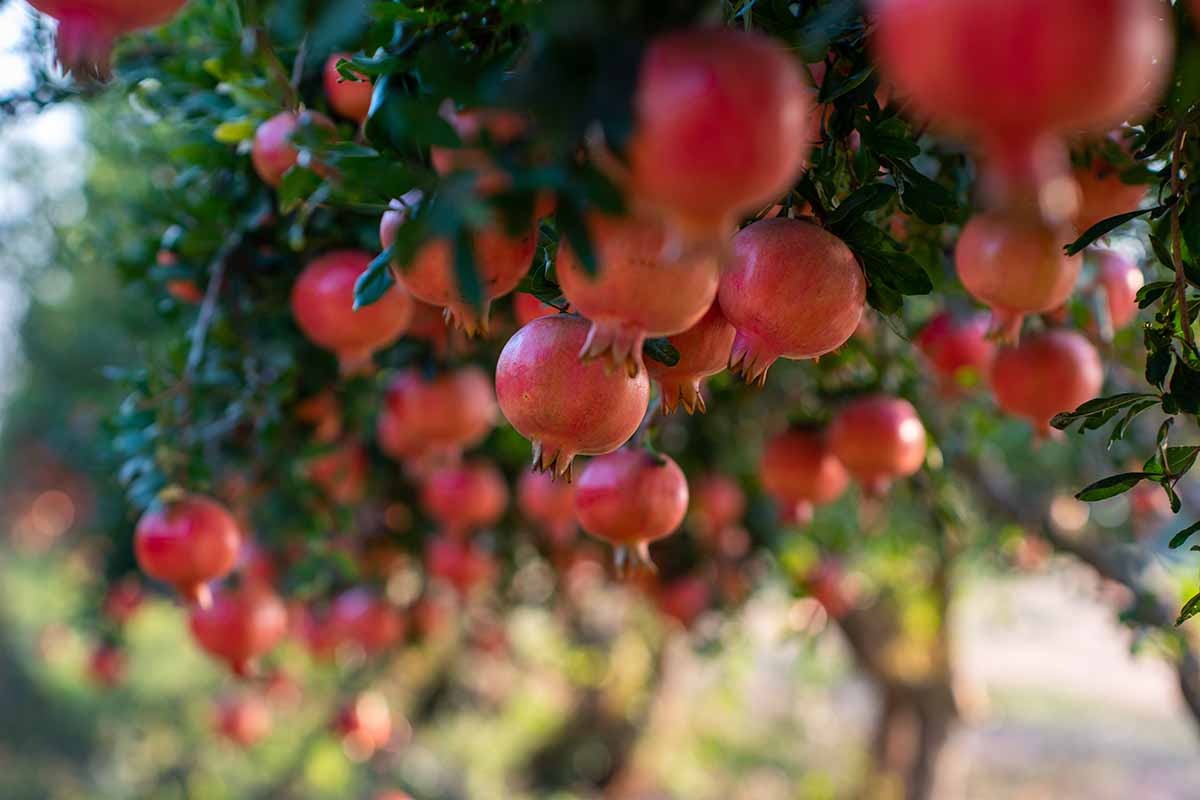
Too much can burn the roots and have the opposite of the desired effect, causing foliage overgrowth and bud or fruit drop.
You don’t want to over-apply foliar sprays either. Trees will be unable to use the excess, and these products can build up on the surface of the leaves. Excessive buildup can prevent water absorption and block sunlight.
The most reliable method of determining soil makeup to get started is to test the soil, which will give you a picture of the soil pH, and the available nutrients. Soil types and other elements may be tested as well.
You can conduct your test at any time of year, but getting results before the winter is best as organic amendments made in the coldest months of the year – such as adding manure and mulch – will have time throughout the dormant season to improve conditions for spring growing.
Amendments made in the spring can also add nutrients as blooms and fruit begin to form.
Don’t apply chemical fertilizers in winter, however, as this can actually cause damage to the dormant tree, and affect fruit production and quality through the growing season.
You can take matters into your own hands by purchasing a soil test kit for home use. One such is the Luster Leaf 1601 Rapidtest Kit, available from Amazon. It will give you an accurate, basic idea of macronutrient levels and pH.

This type of kit works well for the hobby gardener as it contains multiple tests and thorough instructions that work well even for beginners, at a low price.
It shows results for nitrogen, phosphorus, and potassium (noted in the description as potash).
A more comprehensive analysis can be obtained with the My Soil Test Kit, also available from Amazon.

Purchase of this kit includes access to an online profile that not only aids in understanding deficiencies, but offers information on how to amend them for the best results as well.
You may opt for this type of kit if you have a small orchard or you’re planning to produce enough fruit to sell, and you want to make sure your plants have ideal conditions available for maximum yields.
If you’re unsure of how to proceed and you’d like some assistance in understanding testing or in interpreting test results, your local agricultural extension office can be an indispensable resource.
You can locate the office in your region via the Cooperative Extension System website.
It’s best to apply fertilizer only if test results show a deficiency.
If you’ve observed visible signs of plant distress, such as discolored leaves or poor growth, take stock of other factors to be sure that your observations aren’t signs of infestation or disease first, rather than nutrient deficiencies, because fertilizing alone won’t correct those problems.
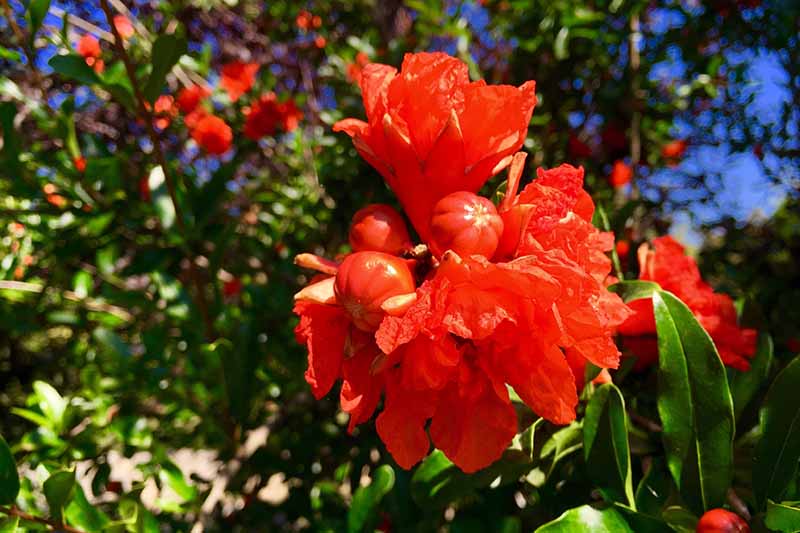
With your test results and observations in mind, you can formulate a plan for fertilizing to correct nutrient levels that are lacking.
A tree that is under two years old should receive two to three pounds of granular fertilizer spread over the root system, applied according to package instructions twice per year, in early spring and early summer.
This amount will cover about 144 square feet, or the space of a 12-by-12-foot square, so you may need to adjust according to the size of your tree.
Avoid applying liquid or granular fertilizer in late summer or fall, as it may trigger new growth or blooming at a time when the plant should be moving in its dormant cycle.
Even if the plant is growing in a region where it remains evergreen, it requires a rest period of semi-dormancy between active growth cycles.
Trees over two years old should be fertilized with one-half to one full pound more granules per application, following the same schedule and based on the size of the tree.
Be sure to spread fertilizers over the entire area of the root system. Any time when you apply granular fertilizer to the soil, you’ll need to thoroughly water afterwards.
Package directions should be followed for the application of liquid fertilizers, whether you are using a ready to spray product, or mixing a liquid or powder with water prior to application.
Another method of adding available nutrients is through application of a foliar spray in early spring and again in early summer.
Foliar sprays should be applied according to package instructions for the size and age of the tree.
Trees Can Sometimes Use a Boost!
If your plants are not as productive as they could be, or the fruits you’re harvesting are small and pale, these may be signs that they could use a little pick-me-up.
While it’s best to avoid overapplication of fertilizers, even for plants that are heavy feeders, a small amount offered annually or twice per year can improve fruit production, foliage health, and growth.

Be sure to test your soil prior to adding any fertilizers! Simple, natural amendments can often add enough organic matter to improve plant health if the soil has become depleted over time.
How do you keep your pomegranate plants healthy and productive? Let us know in the comments section below!
And if you need more information on taking good care of your pomegranate trees, check out these guides next:
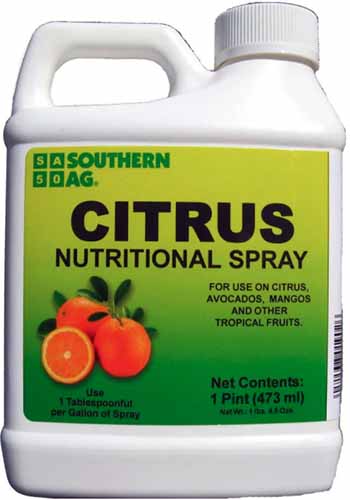
Very informative Kelly, love it. I am from Australia and about to plant a pomegranate in the coming weeks and looking at doing it along a 10 foot fence line. Do you reckon this is OK? I want to train it like a hedge. Your thoughts please.
Thank you, Jake! Typically, pomegranate trees are heat and sun-loving, and grow well positioned in proximity of a structure – provided that they’re receiving quite a bit of pruning each year. Since you’re planning to maintain a compact, shrub shape, they’d be suitable for that type of planting. However, in Australia, where sweltering heat is common in some regions, I’d caution that the reflective heat may be too much for them. This can be particularly true if you’re starting with very young trees that have not acclimated to the environment yet, or grown deep enough roots to access enough water.… Read more »
For the soil test kits what numbers are we looking for for pomegranates? The pH and the NPK. Thank you!
The recommended pH is 5.5 to 7.0, or slightly acidic to neutral. Unless you need to correct an imbalance, balanced fertilizer (with matching NPK numbers) is usually recommended for feeding pomegranates.